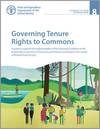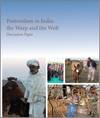Pastoralism is a practice that makes the best use of natural resources in the context of sustainability, availability, and environmental limitations, while producing wealth for the herder families as well as for the nation. This photo feature traces the lifestyle of some of these nomadic herders and shows the hardships they face with a shrinking of their resource base. It serves as a soft advocacy tool and calls for a benevolent state to protect the interests of the pastoralists.
Year of publication: 2016Organization: Auteurs individuels
Topic: Économie, Jeunesse et égalité des sexes, Les savoirs autochtones, Peuples autochtones, Organisation, Participation, Services sociaux
Language: English
Type of document: Technique
Geographical coverage: Asie du Sud
Dans le monde entier, des millions de personnes, incluant les éleveurs nomades, dépendent de biens communs pour leurs moyens de subsistance, leur identité culturelle et leur bien-être. Des droits fonciers garantis sur les biens communs peuvent promouvoir une utilisation des ressources naturelles qui soit durable sur le plan environnemental, et des investissements dans les systèmes de productivité des ressources qui soient responsables. Ce document propose des stratégies pour garantir des droits fonciers légitimes sur les biens communs tels que : des stratégies pour une reconnaissance et une protection juridique, des stratégies pour une mise en œuvre par les États et les détenteurs de droits, et des stratégies d’appui à l’exercice des droits. Sont aussi analysées sept études de cas illustrant des pratiques à travers le monde, ainsi que les moyens méthodologiques à adopter pour une application aux niveaux local et national.
Year of publication: 2016Organization: Organisation des Nations Unies pour l'alimentation et l'agriculture (FAO)
Topic: Sécurité alimentaire, Peuples autochtones, Régime foncier, Participation
Language: English, Français, Español
Type of document: Technique
Geographical coverage: Global
Pastoralists are believed to form 7% of India’s population, i.e., about 88 million people, inhabiting mainly the arid and semi-arid areas of the country. Pastoralism – an old dynamic production system prevalent throughout the world – is economically productive and ecologically sustainable, and uses variability in a positive way. Yet, pastoralism does not get the recognition it deserves. This paper discusses the benefits and challenges of pastoralism and gives ten recommendations how to strengthen pastoralism in India.
Year of publication: 2016Organization: Auteurs individuels
Topic: Économie, Régime foncier, Participation, Services sociaux
Language: English
Type of document: Technique
Geographical coverage: Asie du Sud
En la actualidad, en el medio rural de América Latina, la existencia o prevalencia de las sociedades pastorales no es tan evidente, ya que la agricultura familiar campesina se encuentra en el contexto del cual la relación entre las comunidades y su cría es condición esencial para su sostenibilidad. Contribuyendo a la conservación de la biodiversidad del ecosistema, especialmente de los pastos, y como un recurso esencial para la vida y la producción como fuente de proteínas para alimentos y fibra para uso textil, tanto en la industria como en la industria. Este número de Leisa destaca la importancia de los pastores.
Year of publication: 2016Organization: Auteurs individuels
Topic: Changement climatique, Économie, Services environnementaux, Les savoirs autochtones, Innovation, Organisation, Value addition
Language: Español
Type of document: Bulletins
Geographical coverage: Amérique Latine
In the Sahel, around 65% of the active population works in the agriculture sector and their livelihoods are therefore affected by climate change, markets and environmental factors.
To address these recurrent crises, analytical tools to assess the situation and identify vulnerable
populations have been set in place in the region and refined in recent years. In addition, innovative practices have been developed, to support risk reduction, climate change adaptation, the fight against malnutrition and social protection.
This booklet presents 11 good practices organized around 5 themes, including livestock, with a particular focus on pastoralism.
Year of publication: 2016Organization: Organisation des Nations Unies pour l'alimentation et l'agriculture (FAO)
Topic: Changement climatique, Services environnementaux, Sécurité alimentaire, Jeunesse et égalité des sexes, Participation, Résilience
Language: English
Type of document: Technique
Geographical coverage: Afrique occidentale
A case study highlighting how the Oldokhiin Devjikh pastoralist community in Khuld soum (town) of Dundgobi is surviving under challenging climate conditions. In this part of the Gobi Desert, their initiatives involves building relationships between herding livestock in a traditional way and planting trees to cope with sand movement and land degradation and putting efforts into spring water conservation. This community is a member of Mongolian Alliance of Nomadic Indigenous Peoples (MANIP), which is a national network coordinated by pastoralist leaders supported by FAO`s Pastoralist Knowledge Hub programme.
Year of publication: 2016Organization: Organisation des Nations Unies pour l'alimentation et l'agriculture (FAO)
Topic: Changement climatique, Résilience
Language: English
Type of document: Technique
Geographical coverage: Asie centrale
Les usines laitières modernes utilisent du lait pur et frais pour fabriquer du lait en poudre, du fromage, du yaourt et d’autres produits. L’usine de transformation ne peut fabriquer ses produits qu’avec du lait pur. Lorsqu’on ajoute de l’eau au lait, il devient dilué ou léger, et il n’est pas bon pour la transformation en produits laitiers.
Year of publication: 2016Organization: Auteurs individuels
Topic: Économie, Value addition
Language: English, Français, Hausa, Yorùbá
Type of document: Vidéos
Geographical coverage: Afrique occidentale
Les usines laitières modernes achètent le lait frais des producteurs locaux et des éleveurs pour le transformer en de nombreux produits différents. L’entreprise paie un prix équitable, mais exige une hygiène stricte : elle achète seulement du lait propre et frais.
Year of publication: 2016Organization: Auteurs individuels
Topic: Économie, Value addition
Language: English, Français, Hausa, Yorùbá
Type of document: Vidéos
Geographical coverage: Afrique occidentale









